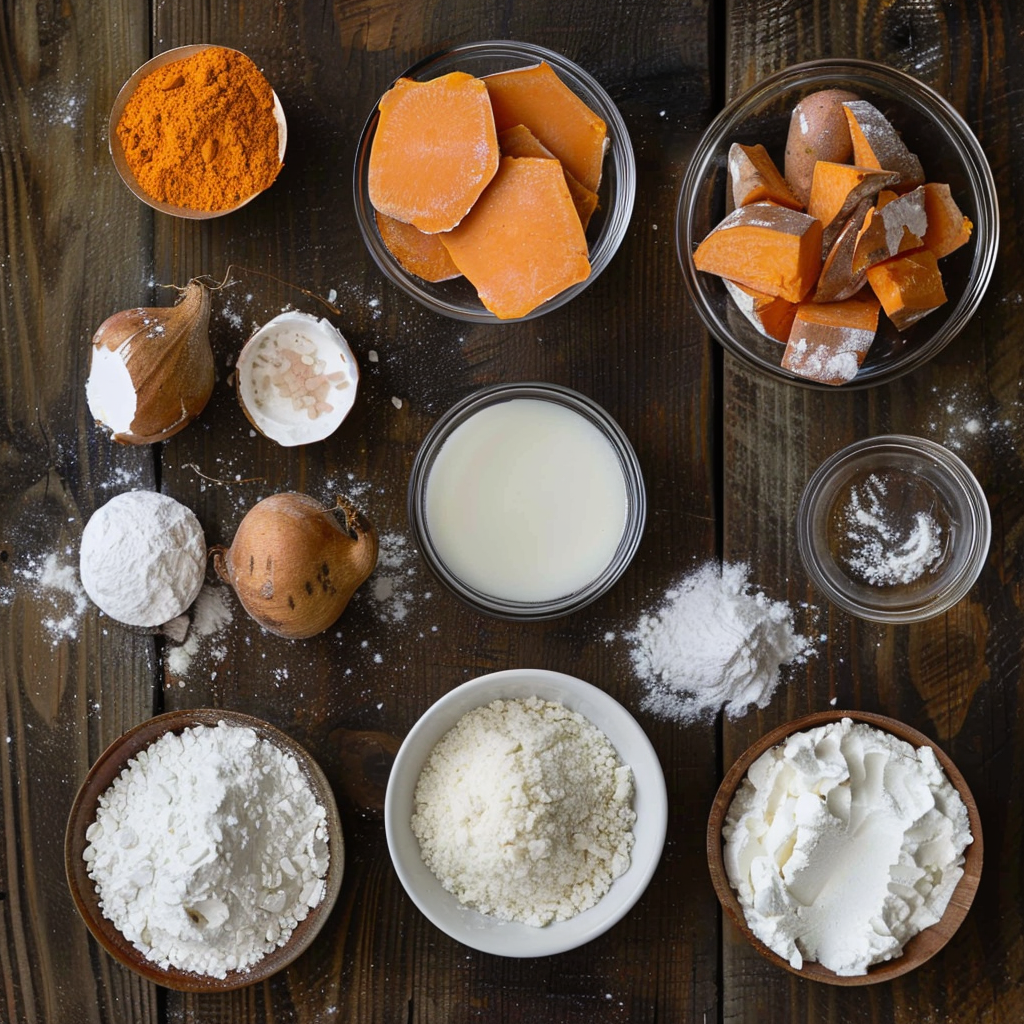Introduction to Can Sweet Potato Pie Recipe
Sweet potato pie is more than just a dessert; it’s a time-honored tradition that melds flavors and history into one beloved dish. Whether you’re planning a holiday meal or just want to indulge in a comforting treat, this can sweet potato pie recipe will delight you with its creamy filling and harmonious blend of spices. But what makes this version unique? By incorporating canned sweet potatoes, the preparation is simplified without compromising taste. You’ll find this guide packed with helpful tips to make the most flavorful pie possible.
The History of Sweet Potato Pie
Cultural Significance and Historical Origins
Sweet potato pie is a beloved dish with deep roots in African American culinary traditions. Its history traces back to the arrival of sweet potatoes in North America during the early colonial period. Sweet potatoes were a dietary staple for enslaved Africans in the Southern United States, who adapted them into various dishes, including the sweet potato pie. This dessert is believed to be a variation of traditional African yam recipes, modified to accommodate the new ingredients available in America.
The pie became more widespread and intertwined with Southern cuisine over time, often associated with celebrations, family gatherings, and holidays like Thanksgiving. It stood as a comforting symbol of resilience, resourcefulness, and cultural preservation. Sweet potato pie also became a counterpoint to pumpkin pie, another holiday staple, thus securing its place in the culinary traditions of the Southern United States.
Regional Variations in Recipes
While sweet potato pie is most closely linked with the South, regional variations add unique twists to the recipe. For instance, some versions might include bourbon or whiskey for added flavor, though non-alcoholic extracts are used for those who prefer alternatives. In Louisiana, Creole versions might include spices like cinnamon, nutmeg, and allspice, as well as a touch of citrus zest.
Further north, sweet potato pie recipes often incorporate maple syrup or molasses as a sweetener. In addition, some recipes from coastal regions may include grated coconut, adding an extra layer of flavor and texture. Some communities might add marshmallow topping or meringue to make the pie even more decadent. Each regional twist highlights the versatility of sweet potato pie and underscores its unique cultural and historical significance.
The Ingredients and Their Role in Sweet Potato Pie Recipe
Key Ingredients (Sweet Potatoes, Sugar, Spices)

The foundation of any good sweet potato pie is the sweet potato itself. Sweet potatoes lend their natural sweetness and creamy texture to the filling, making them the star of this dessert. After baking or boiling, they are mashed and blended with sugar, usually a combination of white and brown sugars, which enhances their natural caramel-like flavor.
Spices such as cinnamon, nutmeg, ginger, and allspice are crucial to achieving the warm, comforting aroma characteristic of sweet potato pie. The blend of these spices, in combination with vanilla extract, creates a depth of flavor that defines the pie. Eggs are used to bind the ingredients together and give the filling its custard-like consistency, while dairy ingredients like butter and evaporated milk add richness and creaminess.
Optional Flavor Enhancers
To further elevate the taste, some recipes include optional flavor enhancers. Lemon or orange zest provides a citrusy brightness that balances the sweetness of the filling. Sweeteners like honey, maple syrup, or molasses offer unique and subtle flavor notes that distinguish one pie from another. A splash of bourbon or rum can add a sophisticated touch, or non-alcoholic flavor extracts can be substituted to replicate these effects.
For a richer, more indulgent taste, some bakers top the pie with marshmallows, whipped cream, or meringue, giving it a visual and textural contrast that complements the smooth filling.
How Canned Ingredients Compare to Fresh
Using canned ingredients, particularly sweet potato puree, can be a convenient and time-saving option. Canned sweet potatoes or puree generally have a softer consistency than fresh, allowing them to be easily mixed into the filling. However, canned versions might not deliver the same robust flavor as fresh sweet potatoes, which many cooks prefer due to their natural sweetness and firmer texture.
Canned evaporated milk, frequently used in the filling, provides a reliable source of rich dairy flavor with a long shelf life. Some recipes also suggest canned pumpkin puree as a substitute for sweet potatoes, though this changes the flavor profile and is less authentic for traditional sweet potato pie.
Ultimately, whether using canned or fresh ingredients, the unique blend of spices and complementary flavors ensures a memorable and delicious dessert.
Preparing Your Sweet Potato Pie Recipe
Choosing Quality Canned Sweet Potato Pie Recipe
When selecting canned sweet potatoes for your pie, quality is essential. Look for cans labeled “cut yams” or “sweet potatoes in syrup.” Make sure the label clearly identifies the content as sweet potatoes and not a blend of other vegetables. Check for no dents, leaks, or signs of damage that could affect the taste or safety. Choose a reputable brand for a consistent and desirable flavor.
Properly Draining and Preparing the Sweet Potatoes
To prevent your pie from becoming watery, ensure that the canned sweet potatoes are thoroughly drained. Pour the contents into a colander and gently press to remove excess liquid. For a smoother texture, mash the sweet potatoes with a fork or use a food processor. If you prefer a chunkier filling, simply mix the sweet potatoes until they reach the desired consistency.
Making the Pie Crust
Different Crust Options (Store-Bought vs. Homemade)
The pie crust is a crucial element that can make or break your dessert. Store-bought pie crusts offer convenience and a consistent product, making them a reliable option for those short on time. Opt for frozen or refrigerated crusts that you can easily shape to fit your pie pan.
On the other hand, homemade pie crusts provide a customizable and fresher taste. By using a blend of flour, butter or shortening, and cold water, you can create a dough that is flaky and buttery, complementing the sweet potato filling perfectly.
Techniques for a Flaky, Golden Crust
Achieving a flaky and golden crust requires the right techniques. If making your own crust, use cold butter or shortening to ensure the fat remains solid during mixing. This creates small pockets that result in flakiness once baked. Handle the dough minimally to avoid overworking it, which can cause toughness.
After shaping the dough, chill it before baking to keep it firm. For a beautifully golden crust, brush it with an egg wash (beaten egg mixed with a splash of water or milk) just before baking. Additionally, pre-baking the crust partially (blind baking) can prevent it from becoming soggy once the filling is added.
Creating the Filling

Mixing the Sweet Potatoes with Other Ingredients
To make the filling, combine your prepared sweet potatoes with sugar, eggs, evaporated milk, and spices in a mixing bowl. Beat the mixture until it becomes smooth and creamy. Adjust sweetness to your preference by adding or reducing the amount of sugar used. A splash of vanilla extract, citrus zest, or other flavor enhancers can give your filling extra character.
Adjusting the Consistency for Optimal Flavor
The consistency of the filling is crucial. It should be thick enough to hold together but still creamy and easy to spread. If the filling appears too thick, gradually add a little more evaporated milk until it reaches the desired texture. Conversely, if it is too thin, consider adding a bit of flour or cornstarch to thicken it up. Once mixed, taste the filling to ensure the spice balance is right before pouring it into the crust.
Baking the Perfect Canned Sweet Potato Pie
Oven Settings and Temperatures
For the ideal texture and flavor, preheat your oven to 350°F (175°C). This temperature allows the filling to set gradually, preventing the eggs from curdling and ensuring an evenly cooked pie. Place your pie on the center rack, which provides a consistent heat distribution. If you’re baking more than one pie, make sure they have enough space around them for proper airflow.
Knowing When the Pie Is Done
Your sweet potato pie is done when the edges are firm, and the center jiggles slightly when the pan is gently shaken. This slight movement means the filling will continue to set as it cools, providing the perfect custard-like consistency. If a knife inserted near the center comes out clean, the pie has likely been overcooked. Check the pie at around 45 minutes, but it could take up to an hour depending on your oven and the size of the pie.
Preventing Cracks in the Filling
Cracks often form in custard pies due to sudden changes in temperature. Avoid overbaking, and allow the pie to cool gradually in the oven by turning off the heat and cracking the oven door. This slow cooling process reduces the risk of cracking. Also, ensure the pie is not placed in a drafty area, as exposure to cold air can cause the filling to crack.
Cooling and Serving the Pie
Allowing the Pie to Set
Once baked, let the pie cool on a wire rack for at least two hours. This allows the filling to fully set, resulting in a smooth and sliceable texture. If you prefer your pie chilled, refrigerate it for an additional two hours or overnight before serving.
Presentation Tips for a Beautiful Dessert
Serve the pie with a dollop of whipped cream or a scoop of vanilla ice cream to complement the flavors. If desired, sprinkle the top with a dash of cinnamon or nutmeg for an added aromatic touch. For an extra festive presentation, garnish with chopped pecans, caramel drizzle, or citrus zest.
Flavor Variations to Try
Adding a Twist with Complementary Spices
Consider experimenting with spices beyond the traditional cinnamon and nutmeg. Cardamom, ginger, and allspice can offer a new depth of flavor. Additionally, try adding a pinch of cayenne or black pepper for a subtle spicy kick that complements the sweetness.
Nutty or Citrusy Accents
Incorporate chopped pecans or walnuts into the filling for added texture and nutty flavor. You can also stir in orange or lemon zest for a bright citrus accent that cuts through the richness of the sweet potatoes.
Creative Toppings and Garnishes
A marshmallow topping or meringue crown creates a beautiful contrast with the filling. For a crunchy topping, bake a streusel made from oats, butter, and brown sugar. Candied pecans or a caramel drizzle can also provide extra layers of flavor and decoration.
Canned Sweet Potato Pie Recipe FAQs
Can I use canned pumpkin instead of sweet potatoes?
- Yes, but this will change the flavor profile, making it more like pumpkin pie.
Why is my pie filling too watery?
It might be due to undercooking or not draining the canned sweet potatoes thoroughly. Extend the baking time and ensure all excess liquid is removed before mixing the filling.
Can I freeze sweet potato pie?
Absolutely. Bake and cool the pie, then wrap it in plastic and aluminum foil. Freeze for up to three months. Thaw in the refrigerator before serving.
Can I use fresh Sweet Potato Pie Recipe instead?
- Yes, simply bake or boil them until soft, then mash thoroughly.
Conclusion: Celebrating Tradition and Taste
Sweet potato pie embodies a blend of history, tradition, and taste. With its warm spices, creamy filling, and buttery crust, it’s a dessert that brings comfort to many and is a staple in many family gatherings. Its versatility allows for creative twists while honoring the classic recipe’s roots. Whether made from canned or fresh sweet potatoes, this beloved pie continues to capture hearts and remain a symbol of culinary tradition.

2 thoughts on “Best Can Sweet Potato Pie Recipe”